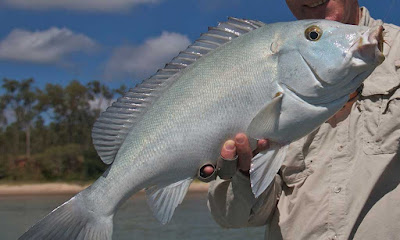
“I wondered what the reviewers of the paper would say about it but they both agreed it was quintessentially Australian and we should go ahead.” Johnson said it was unusual to identify a new species in a fish so large and so well-known through fishing TV programmes and magazines. Due to being native to murky far-northern reef waters swimming with sharks and crocodiles, it had proven understandably elusive, he said. He used photos from fly fisherman Ben Bright to show that the blue bastard’s 12 dorsal spines make it utterly different from a sweetlips species it had previously been confused with. The blue bastard is distinctive in that it changes colour from yellow, dark and light stripes as a juvenile, to a silvery blue in adulthood, when it can grow up to a metre in length.
But it was the adult males’ propensity for “serious combat” through locking jaws and grappling at the water’s surface, in a spectacle dubbed “kissing” by anglers, that really sets the fish apart from related species, Johnson said. “I’ve spoken to a few of the guys and they say they often engage in these episodes and they’re pretty serious about it too,” he said. “One fish will see another one approaching in the distance and he’ll just make a beeline for the other guy and they’ll go at it hammer and tongs.” Johnson worked with geneticist Jessica Worthington Wilmer, using DNA sequence codes to describe this newest member of the sweetlips family, after analysing comparable specimens from Africa, the Middle East and Japan. Johnson has no anecdotal evidence on how the fish tastes but ventured it would not be its finest attribute.

“I haven’t tried it myself and most of the fly fishermen practise catch-and-release so I haven’t spoken to anyone that’s eaten one,” he said. “It’s probably only fair edible quality, I’d suspect, going on the closest relative.” The chief executive of Queensland Museum, Suzanne Miller, said the discovery of the blue bastard was “another exciting achievement” for museum scientists, who described 120 new species in 2014-15. Queensland science and innovation minister Leeanne Enoch said the discovery was proof that museums were “much more than displays of static objects”. She cited the importance of “retaining a pool of talented scientists” in the state by investing in research through the government’s $180m Advance Queensland initiative. The scientific paper on Plectorhinchus caeruleonothus has just been published in the zoological journal Zootaxa.
1 comment:
I propose that that first image isn't a blue bastard, but is in fact a sub-species.. the plotting blue bastard. Its beady eyes implied it knew what was going on, it didn't like it and it was taking notes. It blames YOU.
Post a Comment